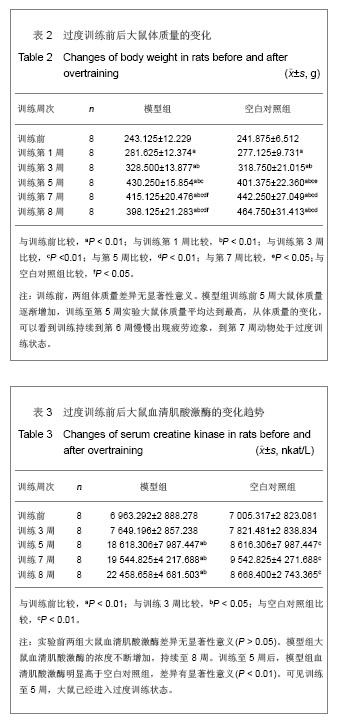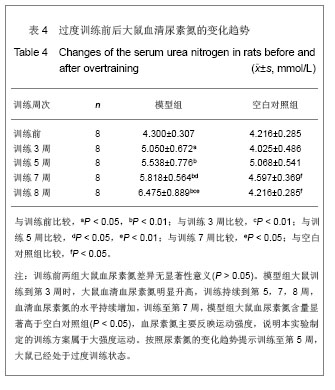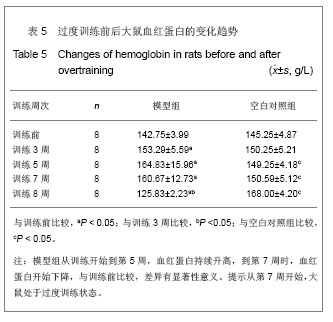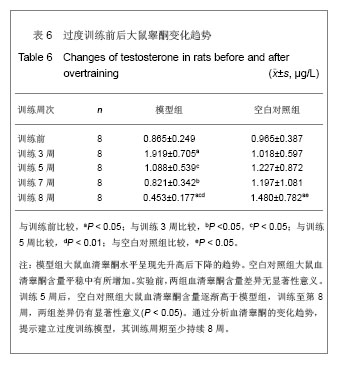中国组织工程研究 ›› 2013, Vol. 17 ›› Issue (46): 8036-8042.doi: 10.3969/j.issn.2095-4344.2013.46.010
• 组织构建实验造模 experimental modeling in tissue construction • 上一篇 下一篇
跑台训练建立过度训练大鼠模型
张 彩,杨华元
- 上海中医药大学体育部运动医学教研室,上海市 201203
Establishment of an overtraining rat model on the treadmill
Zhang Cai, Yang Hua-yuan
- Office of Sports Medicine, Department of Physical Education, Shanghai University of Traditional Chinese Medicine, Shanghai 201203, China
摘要:
背景:过度训练是运动负荷与机体机能不相适应,以至疲劳连续累积而引起的一系列功能紊乱或病理状态。目前建立过度训练大鼠模型的常用训练方法有跑台、游泳、爬杆等方式,但国际上比较认可跑台法。 目的:通过动态监测运动大鼠的生化指标,同时观察其行为学改变,确立建立过度训练大鼠模型的建模标准,实现过度训练大鼠模型建模客观化。 方法:16只SD大鼠随机均分为模型组与空白对照组。模型组按训练计划进行运动训练,大鼠适应性喂养后开始训练,每周训练6 d,休息1 d,采用递增强度跑台运动,从训练第1周起,逐渐递增速度、坡度和跑步时间;而空白对照组常规饲养,不进行训练。 结果与结论:运动5周后大鼠出现过度训练行为学改变。训练过程中,血清肌酸激酶持续增加,5周后高于基础水平(P < 0.01);血清尿素氮持续增加,3周后高于基础水平(P < 0.05);而大鼠血红蛋白、血清睾酮呈现先升高后下降的趋势,8周后显著低于基础水平(P < 0.05)。大鼠行为学上出现过度训练状态,同时血红蛋白、血清睾酮显著低于基础水平,血清肌酸激酶、血清尿素氮显著高于基础水平,提示运动机体处于过度训练状态。实验确立了过度训练大鼠的建模标准。按照实验训练方案,跑台速度为30 m/min、每次训练时间为 110 min、坡度为15°时,训练持续至第8周可以建立过度训练大鼠模型。
中图分类号:




.jpg)
.jpg)
.jpg) 血尿素氮、肌酸激酶、血清睾酮、血红蛋白是目前公认的可以客观的反映运动机能的生化指标。其中血尿素氮与肌酸激酶反映运动强度,训练3-5周后显著低于基础水平,说明本课题的训练方案属于大强度运动;而血清睾酮和血红蛋白反应机体的运动机能,训练7至8周后才显著低于基础水平。在今后相关的科研工作中,在建立过度训练模型或监测运动训练时,训练初期或中期可以选择观察血尿素氮、肌酸激酶的变化以调整训练负荷,训练中期或后期可以开始检测血清睾酮和血红蛋白,观察机体的运动机能。
血尿素氮、肌酸激酶、血清睾酮、血红蛋白是目前公认的可以客观的反映运动机能的生化指标。其中血尿素氮与肌酸激酶反映运动强度,训练3-5周后显著低于基础水平,说明本课题的训练方案属于大强度运动;而血清睾酮和血红蛋白反应机体的运动机能,训练7至8周后才显著低于基础水平。在今后相关的科研工作中,在建立过度训练模型或监测运动训练时,训练初期或中期可以选择观察血尿素氮、肌酸激酶的变化以调整训练负荷,训练中期或后期可以开始检测血清睾酮和血红蛋白,观察机体的运动机能。